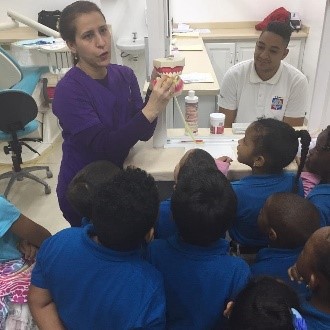Digging Deeper: What Have We Learned from this Year?

What a year this has been! My guess is that when you started school you didn’t foresee weeks of school closures, a global pandemic, the evacuation of friends and students, disrupted patterns of teaching and learning, riots in the streets, or distributing food to the needy in your community. And yet, while we might have been blindsided by the events of the first half of 2020, we know that our Lord was not. He is the one who called us and appointed us to care for our students and communities in “such a time as this.”
Now that the academic year (for many) is ending and local restrictions are beginning to ease, we have the opportunity reflect on what we’ve learned over these last six months. Sudden, traumatic change has a way of uncovering the thoughts, attitudes and behaviours that dwell deep underneath the surface of our conscious thought. In the moment, we find ourselves simply reacting, doing what we can to survive the onslaught. However, we would be foolish not to stop and reflect on these things once the situation stabilises. In many ways, this exposure is a gift. It offers us a rare opportunity to consciously examine those things we normally don’t even consider thinking about.
As you process the events of this spring, here are some questions for you to consider:
- What is there to celebrate? We were faced with so many hard things all at once that we may lose sight of the fact that in the midst of the trials some lovely things were exposed. What did you, your students, your school do well during this time? What brought you moments of joy? What positive patterns or new ways of thinking, feeling, or doing emerged?
- What evidence do you have of the work of transformation that the Lord is doing in your heart, life, and teaching through this time? We may have been caught up in a cycle of reaction and survival, but God was not. We know that He who began a good work in you will carry it on to completion until the day of Christ Jesus[1], and that our light and momentary troubles are achieving for us an eternal glory that far outweighs them all.[2] So what has He been doing in your heart through the challenges you’ve faced during this time? Where can you see His hand at work in your life?
- How will what you’ve learned—personally and professionally—influence the way you approach teaching in the future? Are there elements of distance learning that worked so well you want to keep them or adapt them for use in the future? What about the ways you communicated with families and students? How might this year spur your thinking about other types of disruptions schools face—snow days, political protests, natural disasters, even student illness?
- What areas of weakness were exposed during this time? How will you proactively address these for the future? While I certainly hope that we don’t face another global pandemic or other disruption of this magnitude in our lifetimes, there is no guarantee that we won’t. And we are almost certainly guaranteed to face other unexpected difficulties or disruptions. So what can we do now to help prepare us for the next time—whatever that next time might look like? Who will we share this with to help hold us accountable?
Let us collectively rejoice that we’ve survived another school year. Let
us grieve the losses we need to grieve. But let us not remain there. Let
us take the next step and invite the Holy Spirit to show us where He was—and
still is—at work in our lives, in our classrooms, in our schools and in our
communities. May we look back on the spring of 2020 not just as a time of
global pandemic and challenge and loss, but also as a time of great learning
and deep transformation.
Becky Hunsberger, M.Ed.
Coordinator of Teacher
Education Services
TeachBeyond Global
[1] Phil. 1:6
[2] 2 Cor. 4:17
Photo Credits: Boy with Mask. via Shutterstock.















 Thus a yearly curriculum plan will have far less detailed than a unit plan, which will be less detailed than a daily lesson plan.
Thus a yearly curriculum plan will have far less detailed than a unit plan, which will be less detailed than a daily lesson plan. determine how many days will likely be needed for students to reach these objectives. At this stage, you might consider the following:
determine how many days will likely be needed for students to reach these objectives. At this stage, you might consider the following:

 I want to offer some thoughts from a book called The Gift of the Stranger: Faith, Hospitality and Language Learning[1], a work I recommend to all language teachers–foreign or mother-tongue, all who find themselves as learners in a foreign culture, or all who welcome others into their own culture—in short, nearly all of us in TeachBeyond!
I want to offer some thoughts from a book called The Gift of the Stranger: Faith, Hospitality and Language Learning[1], a work I recommend to all language teachers–foreign or mother-tongue, all who find themselves as learners in a foreign culture, or all who welcome others into their own culture—in short, nearly all of us in TeachBeyond! have not love, I am a noisy gong or a clanging cymbal.[6]” On the other side, we can meet the stranger with all the love in the world, but if we cannot communicate that love in a way that he or she can receive it—with words or not, with correct grammar or without—it will still sound like a noisy gong. We can certainly communicate love without words, but learning language is a gift to the people with whom we wish to connect; it is one of the ways we communicate love. Let’s not forget that truth in the language classroom.
have not love, I am a noisy gong or a clanging cymbal.[6]” On the other side, we can meet the stranger with all the love in the world, but if we cannot communicate that love in a way that he or she can receive it—with words or not, with correct grammar or without—it will still sound like a noisy gong. We can certainly communicate love without words, but learning language is a gift to the people with whom we wish to connect; it is one of the ways we communicate love. Let’s not forget that truth in the language classroom.
 Accept the challenge to join colleagues in thinking hard, discussing often, and praying fervently about this all too common stumbling block around suffering. How can we prepare our students with a theology of suffering that equips them to stand firm in the faith even when faced by “trials and tribulations of many kinds ” (5)? How can we facilitate discussions surrounding prayer that avoid the “Cosmic Sugar Daddy” trap? What messages are our lives sending to our students—both explicitly and tacitly—about suffering and disappointed expectations?
Accept the challenge to join colleagues in thinking hard, discussing often, and praying fervently about this all too common stumbling block around suffering. How can we prepare our students with a theology of suffering that equips them to stand firm in the faith even when faced by “trials and tribulations of many kinds ” (5)? How can we facilitate discussions surrounding prayer that avoid the “Cosmic Sugar Daddy” trap? What messages are our lives sending to our students—both explicitly and tacitly—about suffering and disappointed expectations?